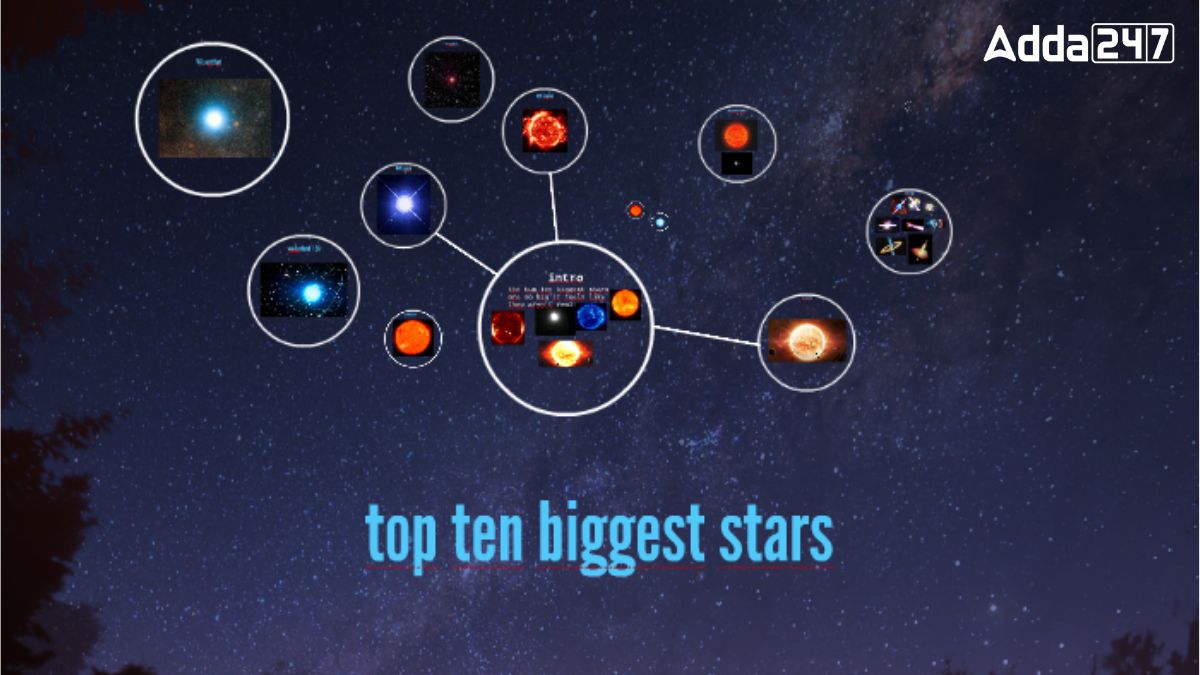The universe is an immense and enigmatic realm, brimming with celestial marvels that captivate both astronomers and space enthusiasts. Among these cosmic phenomena, stars are the dazzling lights that illuminate the night sky. Some of these stars are so extraordinarily large that they challenge our grasp of scale. This article delves into the top 10 largest stars in the universe, showcasing their colossal size and the incredible forces that shape their existence.
What is a Star?
A star is a luminous celestial object primarily composed of hydrogen and helium undergoing nuclear fusion in its core. This process generates immense heat and light, resulting in the emission of energy that illuminates the surrounding space. Stars play a crucial role in the universe, serving as the fundamental building blocks of galaxies and influencing the development of planetary systems.
Largest Star in the Universe
UY Scuti, the largest known star in our galaxy and one of the most massive ever discovered, dwarfs the sun, being over 1,700 times its size. To emphasize its colossal scale, one could accommodate more than 5 billion suns within UY Scuti. Despite its immense dimensions, UY Scuti is merely ten times the sun’s mass and shines 100,000 times as brightly. Approaching the end of its life, this giant star has expanded significantly. Eventually, it will culminate in a supernova, potentially leaving behind a neutron star or black hole.
Key Facts Related to the Biggest Star in the Universe
Here are some of the key facts related to the biggest star in the universe:
- Size and Radius: UY Scuti, located in the Scutum constellation, is over 1,700 times larger than the Sun, with an estimated radius fluctuating between 1,708 and 755 solar radii.
- Volume Comparison: By volume, UY Scuti could contain nearly 5 billion Suns, emphasizing its colossal nature and challenging our understanding of stellar dimensions.
- Brightness and Variability: Despite its massive size, UY Scuti is only ten times the mass of the Sun but shines 100,000 times as brightly. It is a pulsating variable star, with magnitude variations ranging from 8.29 to 10.56.
- Distance from Earth: UY Scuti is approximately 1.8 kiloparsecs (5,900 light-years) away from Earth, adding to the challenge of studying its intricate details.
- Nomenclature and Discovery: First catalogued in 1860 as BD-12°5055, UY Scuti was later identified as a variable star during a survey, leading to its designation as the 38th variable star in the Scutum constellation.
- Characteristics: Classified as a dust-enshrouded bright red supergiant, UY Scuti is a semiregular variable with a pulsation period of approximately 740 days.
- Interferometry Measurements: Using AMBER interferometry with the Very Large Telescope (VLT), UY Scuti’s size was measured as 1,708 ± 192 solar radii, making it the largest and most luminous among three red supergiants studied.
- Mass and Mass Loss: UY Scuti’s mass is uncertain, theoretically expected to be between 7 and 10 solar masses. Mass loss occurs at a rate of 5.8×10−5 solar masses per year, creating a complex circumstellar environment.
- Supernova Evolution: Current models suggest that UY Scuti has begun helium fusion and is expected to evolve into a yellow hypergiant, luminous blue variable, or a Wolf–Rayet star before eventually undergoing a core collapse supernova.
- Metallicity and Core Processes: Situated deep within the Milky Way, UY Scuti’s metal-rich composition influences its stellar evolution, and as it fuses heavy elements like iron, it is set to experience a transformative supernova event.
Top-10 Biggest Stars in the Universe
UY Scuti within the constellation Scutum, with the diameter of 1,700 solar radii, holds the title of the biggest star in the universe, followed by VY Canis Majoris, RW Cephei, and V345 Cephei.
Here is the list of top-10 biggest stars in the universe:
| Largest Stars in the Universe | ||||
| Rank | Stars | Constellation | Distance (light year) | Diameter (solar radii) |
| 1. | UY Scuti | Scutum | 5,900 | 1,700 |
| 2. | VY Canis Majoris | Canis Majoris | 3,900 | >1,500 |
| 3. | RW Cephei | Cepheus | 3,500 | 1,530 |
| 4. | V354 Cephei | Cepheus | 8,900 | 1,520 |
| 5. | KY Cygni | Cygnus | 5,000 | 1,430 |
| 6. | Mu Cephei | Cepheus | 2,838 | 1,200 |
| 7. | VV Cephei A | Cepheus | 5,000 | 1,050 |
| 8. | KW Sagittarii | Sagittarius | 6,200 | 1,090 |
| 9. | Betelgeuse | Orion | 640 | 887 |
| 10. | Antares | Scorpius | 550 | 832 |
Biggest Star in the Universe – UV Scuti
Constellation: Scutum
Distance: 5,900 light years
Diameter: 1,700 solar radii
UY Scuti, the largest known star in our galaxy and one of the most massive in the universe, dwarfs the sun, being over 1,700 times larger by volume. To emphasize its colossal size, more than 5 billion suns could easily fit within UY Scuti. However, despite its immense volume, UY Scuti is only ten times more massive than our sun and shines a staggering 100,000 times brighter.
As UY Scuti reaches the final stages of its life, its gigantic proportions are a result of the star’s expansion in its aging process. Eventually, this massive star is expected to culminate its existence in a spectacular supernova explosion, with the remnants potentially forming a neutron star or a black hole.
Second Largest Star in the Universe – VY Canis Majoris
Constellation: Canis Majoris
Distance: 3,900 light years
Diameter: >1500 solar radii
VY Canis Majoris stands out as one of the most colossal, massive, and luminous stars ever documented in the cosmos. Surpassing the size of 1,500 suns, this astronomical giant boasts a weight equivalent to approximately 60 suns, gauged by its brilliance that outshines our sun by a remarkable 400,000 times. Residing in the Canis Majoris constellation, VY Canis Majoris is classified as a hypergiant star, positioned around 3,900 light years away from us. Despite its massive proportions, this cosmic behemoth is relatively youthful, estimated to be less than ten million years old.
Third Biggest Star in the Universe – RW Cephei
Constellation: Cepheus
Distance: 3,500 light years
Diameter: 1,530 solar radii
Situated in the Cepheus constellation and positioned approximately 3,500 light years from Earth, RW Cephei is a yellow hypergiant star. Its immense scale, estimated to be 1,530 times larger than our sun, surpasses even the orbit of Jupiter. In the hierarchy of cosmic giants, RW Cephei claims the title of the third-largest star known in the universe.




 What was the Old Name of Bihar? Know Abo...
What was the Old Name of Bihar? Know Abo...
 Which River is known as the Diamond Rive...
Which River is known as the Diamond Rive...
 Which Dry Fruits are known as the King o...
Which Dry Fruits are known as the King o...







